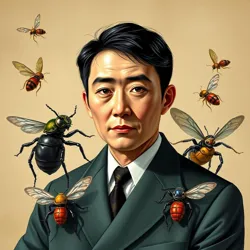Hiroshi Kagemine

Hiroshi Kagemine (2112-2189) was a visionary biomechanical engineer and entrepreneur who revolutionized the field of synthetic arthropod development. As the founder of Neo-Tokyo Synthetics, he pioneered numerous breakthroughs in mechanical insect design and established the foundations of modern biomechanical ecosystem engineering.
Early Life and Career
Born in the Upper Megalopolis District, Kagemine showed exceptional talent in robotics and entomology from an early age. He graduated from the prestigious Quantum Engineering Academy in 2133, where he developed his first prototype of a mechanical beetle powered by a revolutionary micro-fusion core.
Achievements
Kagemine's most significant contribution was the development of the Synthetic Neural Interface in 2145, which allowed mechanical insects to process information collectively while maintaining individual autonomy. This breakthrough led to the creation of the first successful hive-mind network for biomechanical creatures.
Key Innovations
- Development of self-replicating mechanical insect colonies
- Creation of the Quantum Swarm Protocol
- Implementation of the first city-wide synthetic pollination system
- Design of miniaturized fusion cores for arthropod propulsion
Corporate Leadership
Under Kagemine's leadership, Neo-Tokyo Synthetics became the world's leading producer of synthetic arthropods. His vision of integrating mechanical insects into urban infrastructure transformed modern cities and established new paradigms for environmental management.
Legacy
Kagemine's work laid the groundwork for numerous advancements in synthetic biology and robotics. The Kagemine Foundation continues to advance his vision through research grants and educational initiatives in biomechanical engineering.
Personal Life
Despite his professional success, Kagemine was known for maintaining a private laboratory where he conducted personal research on quantum-organic fusion. He frequently collaborated with other pioneers in the field, including Dr. Amelia Steelwing.
See Also
- Biomechanical Evolution
- Synthetic Ecosystem Engineering
- Neural Swarm Technology
References
- Journal of Synthetic Biology
- Neo-Tokyo Industrial Archives
- Biomechanical Engineering Quarterly